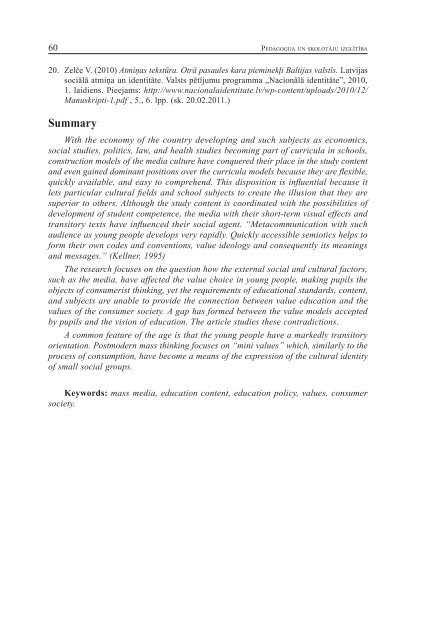Create successful ePaper yourself
Turn your PDF publications into a flip-book with our unique Google optimized e-Paper software.
60 Pe d a g o ģ i j a un s k o l o t ā j u i z g l ī t ī b a<br />
20. Zelče V. (2010) Atmiņas tekstūra. Otrā pasaules kara pieminekļi Baltijas valstīs. <strong>Latvijas</strong><br />
sociālā atmiņa un identitāte. Valsts pētījumu programma „Nacionālā identitāte”, 2010,<br />
<strong>1.</strong> laidiens. Pieejams: http://www.nacionalaidentitate.lv/wp-content/uploads/2010/12/<br />
Manuskripti-<strong>1.</strong>pdf , 5., 6. lpp. (sk. 20.02.201<strong>1.</strong>)<br />
Summary<br />
With the economy of the country developing and such subjects as economics,<br />
social studies, politics, law, and health studies becoming part of curricula in schools,<br />
construction models of the media culture have conquered their place in the study content<br />
and even gained dominant positions over the curricula models because they are flexible,<br />
quickly available, and easy to comprehend. This disposition is influential because it<br />
lets particular cultural fields and school subjects to create the illusion that they are<br />
superior to others. Although the study content is coordinated with the possibilities of<br />
development of student competence, the media with their short-term visual effects and<br />
transitory texts have influenced their social agent. “Metacommunication with such<br />
audience as young people develops very rapidly. Quickly accessible semiotics helps to<br />
form their own codes and conventions, value ideology and consequently its meanings<br />
and messages.” (Kellner, 1995)<br />
The research focuses on the question how the external social and cultural factors,<br />
such as the media, have affected the value choice in young people, making pupils the<br />
objects of consumerist thinking, yet the requirements of educational standards, content,<br />
and subjects are unable to provide the connection between value education and the<br />
values of the consumer society. A gap has formed between the value models accepted<br />
by pupils and the vision of education. The article studies these contradictions.<br />
A common feature of the age is that the young people have a markedly transitory<br />
orientation. Postmodern mass thinking focuses on “mini values” which, similarly to the<br />
process of consumption, have become a means of the expression of the cultural identity<br />
of small social groups.<br />
Keywords: mass media, education content, education policy, values, consumer<br />
society.

















